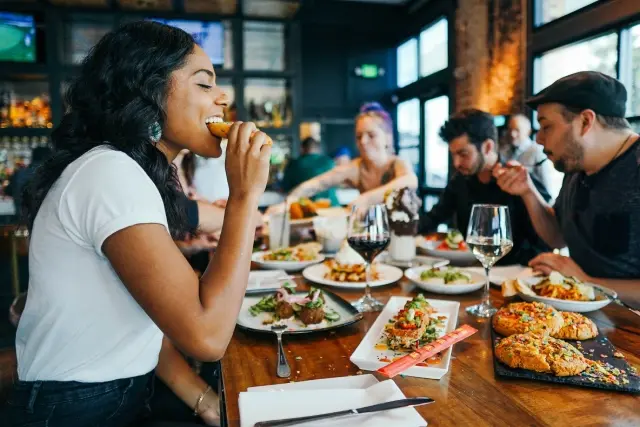You already knew running a restaurant was a financial risk. According to the U.S. Bureau of Labor Statistics, around 17% of restaurants close during their first year.
So, if you want your business to stay afloat, or better yet, turn a profit, you’ve got to adapt. With restaurant budgeting tactics, restaurant owners can offset rising business costs and have a lucrative, long-lasting business.Here’s a quick preview of what we’ll cover:
- Simplify your menu
- Streamline your hiring process
- Prioritize retaining your staff
- Reduce food waste
- Invest in self-ordering kiosks
- Add more flexibility to your budget
But before we get into all of that, let’s start with a question that’s probably on your mind…
Which business costs are increasing for restaurant owners?
No matter what type of restaurant you’re running, there are a few rising business costs you need to know about, especially when considering restaurant budgeting. Let’s take a look at each.
Restaurant labor costs. Fast food and restaurant workers are demanding higher pay nationwide. Many are pushing to increase the minimum wage to at least $15/hour. Whether you agree or disagree with this push for higher wages isn’t so important—at least not in this current conversation. What is important is that you realize that hiring new, qualified employees will likely become more competitive and expensive from now on.
Shipping and logistics costs. The labor shortage isn’t just affecting your restaurant business. It’s affecting the shipping companies that are essential to your food supply chain. With increased safety regulations, there are fewer truck drivers on the road and fewer people interested in the profession altogether. As a result, the price for goods delivered to you has increased. Chai Pani Restaurant Group COO Stack revealed that their business costs have increased 3-4% due to higher delivery costs.
Wholesale food costs. According to the U.S. Bureau of Labor Statistics, wholesale food prices have increased by 1% every month since the beginning of 2021. And that cost burden has been put on restaurant owners as raw ingredients are now more expensive. The owner of Jeju Noodle Bar in New York City had to take chicken wings off their menu to avoid upsetting customers with insane prices.
Safety and sanitation costs. Your restaurant budget now needs to account for new Covid safety regulations. As you probably know, the price of cleaning and sanitary items, such as gloves, masks, disinfectants, and hand sanitizer, is now a significant addition to your business expenses. The owner of Matador Tacos and Tapas reports spending about $800/month on disinfecting services.
6 restaurant budgeting tips to offset rising business costs
You can’t really control any of the rising business costs we just shared. But you know what is in your control? The power to adapt and adjust restaurant budgets by doing things like...
#1 Simplify your menu
Does your menu really need all of your current offerings? Probably not. So, get critical and strategic by removing items that your customers aren’t really buying.
Why do this? Because it will help you reduce your wholesale food costs, allowing you to purchase in bulk the items you need for your remaining menu offerings. But before committing to one final simplified menu, you may want to try out different versions of the shortened menu to see how it affects your monthly earnings and customer satisfaction.
IHOP shortened its menu from 12 pages to 2 pages by keeping popular items that are easy to prepare. This change has made it easier for IHOP franchises to train new workers and reduce waste from unused ingredients.
#2 Streamline your hiring process
You know how hard it can be to find and hire quality candidates. You probably also know that it isn’t just difficult. It’s also time-consuming and costly—especially during the current labor shortage.
Our recommendation? Evaluate and improve your hiring process. For example, you can do things like:
- Eliminate redundancy in your application form (e.g. asking candidates to submit a resume and also manually fill in information about their work experience)
- Remove questions that are unnecessary for the job at hand or can be found in the applicant’s resume—these questions can deter top applicants
- Invest in HR technology that makes it easy for you to evaluate and easily follow up with the applicants who have the most potential for success
For example, take a look at this Chick-fil-A franchisee’s success in improving their hiring process. By adopting Workstream’s all-in-one hiring solution, they managed to get four times as many qualified applicants as before and reduce their interview no-show rates by 50%.
#3 Prioritize retaining your staff
Do you know your staff turnover rate? If not, you should. Because staff turnover is a hidden labor cost for any type of business. By retaining quality staff members, you don’t have to spend time, money, and resources on hiring. According to a Gallup survey, replacing an employee can cost one-half to two times that employee's salary.
So, what are some things you can do to reduce turnover and boost retention? Invest in your employees. For example, you might offer additional training to help them grow professionally in ways that are directly and indirectly related to their role.
The Boston-based restaurant Tuscan Brands offers hands-on culinary school training to all of their employees. Do all of their employees need this training to do their job? Nope! But it gives them the opportunity to learn more about the restaurant’s offerings while gaining skills they can use to advance their career.
#4 Reduce food waste
This isn’t just a tip to be more eco-friendly. With wholesale food costs up, it’s time to get serious about reducing food waste. According to a recent report from Champions 12.3, for every $1 invested in programs to reduce food waste, restaurant budgets save an average of $7 in operating costs.
What steps can you take to implement a successful food waste reduction program? Start by auditing the amount of food your restaurant wastes per month. During your audit, categorize the waste to get an idea of where the majority comes from (e.g. spoiled inventory, kitchen scraps). Then look for ways to either repurpose the waste, adopt tools to better manage your inventory, or stop buying or buy less of the frequently wasted products.
#5 Invest in self-ordering kiosks
With changes in consumer behavior, self-ordering kiosks deserve your attention. Yes, purchasing this technology requires a financial investment. But it’s worth fitting into your restaurant budgets. Why? Because the return on investment, now and in the near future, could be huge.
Here are two examples of restaurants that have benefited from this strategy:
- McDonald’s increased their sales by 5-6% in one year after introducing self-service kiosks
- Chili’s introduced the self-order service Ziosk and had a 20% increase in appetizer sales
What makes the self-ordering kiosks particularly useful? For one, they can help reduce labor costs. They also help to enhance customer experience by reducing order errors. Lastly, the contactless nature of self-ordering kiosks aligns with customer expectations for safety.
#6 Add more flexibility to your budget
Flexibility is key to every aspect of your business, including your restaurant budget. By having a flexible budget, you can more easily pivot your focus on spending or saving if needed.
As we mentioned earlier, expenses for things such as takeaway containers and sanitary items have increased the average operating costs for a restaurant. On top of that, you probably need to invest more in digital marketing to attract customers who now spend more time online.
How can you start adding more flexibility to your restaurant budget? Aim to create multiple budgets that account for different scenarios and ongoing uncertainty. For example, you can create three different budgets that you can consider conservative, moderate, and aggressive. To make this process more efficient, consider investing in restaurant accounting software.
Final thoughts
The average operating costs of a restaurant have increased. This is in large part due to higher costs for labor, logistics and shipping, wholesale food orders, and safety regulations.
These things are largely out of your control. But that doesn’t mean your restaurant’s financial future is doomed! By being strategic, you can get innovative in your restaurant operations and approach to restaurant budgeting.





